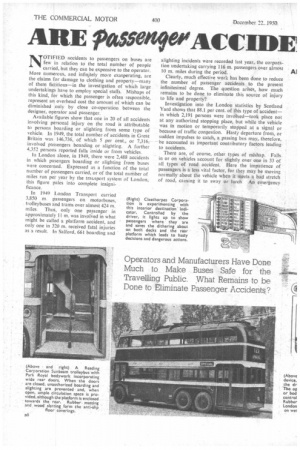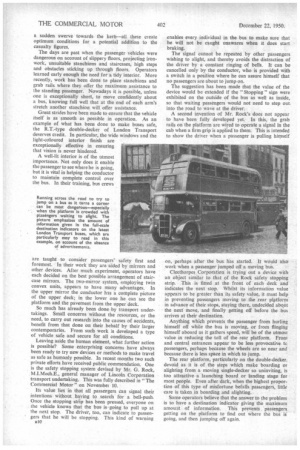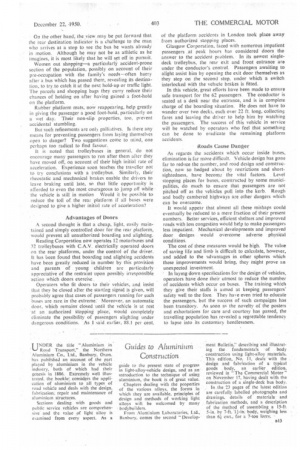ARE redgettfeeACCIDE
Page 42

Page 43

Page 44

Page 47

If you've noticed an error in this article please click here to report it so we can fix it.
S INEVIT
NOTIFIED accidents to passengers on buses are few in relation to the total number of people carried, but they can be expensive to the operator. More numerous, and infinjtely more exasperating, are the claims for damage to clothing and property—many of them fictitious—in the investigation of which large undertakings have to employ special staffs. Mishaps of this kind, for which the passenger is often responsible, represent an overhead cost the amount of which can be diminished only by close co-operation between the designer, operator and passenger.
Available figures show that one in 20 of all accidents involving personal injury on the road is attributable to persons boarding or alighting from some type of vehicle. In 1949, the total number of accidents in Great Britain was 146,736, of which 5 per cent., or 7,316; involved passengers boarding or alighting. A further 4,352 persons reported falls inside or from vehicles.
In London alone, in 1949, there were 2,488 accidents in which pasengers boarding or alighting from buses were concerned. Expressed as a function of the total number of passengers carried, or of the total number of miles run per year by the trat,sport system of London, this figure pales into complete insignificance.
In 1949 London Transport carried 3,850 m. passengers on motorbuses, trolleybuses and trams over almost 424 m.
miles. Thus, only one passenger in approximately 11 m. was involved in what might be called a platform accident, and only one in 320 m. received fatal injuries as a result. In Salford. 661 boarding and alighting incidents were recorded last year, the corporation undertaking carrying 116 m. passengers over almost 10 m. miles during the period.
Clearly, much effective work has been done to reduce the number of passenger accidents to the present infinitesimal degree. The question arises, how much remains to be done to eliminate this source of injury to life and property?
Investigation into the London statistics by Scotland Yard shows that 88.1 per cent. of this type of accident— in which 2,191 persons were involved—took place not at any authorized stopping place, but while the vehicle was in motion or temporarily stopped at a signal or because of traffic congestion. Hasty departure from, or sudden impulses to catch, a passing bus may, therefore, -be accounted as important contributory factors leading to accidents.
There are, of course, other types of mishap. Falls in or on vehicles account for slightly over one in 33 of all types of road accident. Here the impatience of passengers is a less vital factor, for they may be moving normally about the vehicle when it meets a bad stretch of road, causing it to sway or lurch An emergency
brake application by the driver to avert some external danger may affect the passengers. The condition of the road or of the springs and chassis may be accounted as partially responsible for any subsequent accident.
In all instances, however, three main factors must be taken together in considering the nature of the accident. The human one is possibly the most important. and impatience and impulsiveness are probably the individual traits, which create most trouble. Tbe mechanical one is important, and cannot be divided from the human aspeo Affecting both are the external elements
—road and traffic conditions, weather, and many others.
The mechanical factor includes rapid acceleration and heavy braking, which make it difficult for a passenger— particularly an elderly one, or a person with an armful of parcels—to keep his or her balance. Badly cambered roads—a physical characteristic—have a similar effect. Rain, wet platforms and greasy floors, or a dark day when the level of natural illumination makes movement in the interior difficult, are further examples of the incidence of physical conditions.
An impatient driver on a bus with inefficient transmission, a conductor anxious about his time-keeping, a passenger who leaves his seat in order to be ready to leave the bus as it pulls up—perhaps rapidly and with a sudden swerve towards the kerb—all these create optimum conditions for a potential addition to the casualty figures.
The days are past when the passenger vehicles were dangerous on account of slippery floors, projecting ironwork, unsuitable stanchions and staircases, high steps and obstacles sticking up through floors. Operators learned early enough the need for a tidy interior. More recently, work has been done to place stanchions and grab rails where they offer the maximum assistance to the standing passenger. Nowadays it is possible, unless one is exceptionally short, to move confidently about a bus, knowing full well that at the end of each arm's stretch another stanchion will offer assistance.
Great strides have been made to ensure that the vehicle itself is as smooth as possible in operation. As an example of what has been done to make buses safe, the R.T.-type double-decker of London Transport deserves credit. In particular, the wide windows and the light-coloured interior finish are exceptionally effective in ensuring that vision is never hindered.
A well-lit interior is of the utmost importance. Not only does it enable the passenger to see where he is going, but it is vital in helping the conductor to maintain complete control over the bus. In their training, bus crews are taught to consider passengers' safety first and foremost. In their work they are aided by mirrors and other devices. After much experiment, operators have each decided on the best possible arrangement of staircase mirrors. The two-mirror system, employing twin convex units, appears to have many advantages. In the upper mirror the conductor has a complete picture of the upper deck; in the lower one he can see the platform and the pavement from the upper deck.
So much has already been done by transport undertakings. Small concerns without the resources, or the need, to carry out research into the causes of accidents, benefit from that done on their behalf by their larger contemporaries. From such work is developed a type of vehicle safe and secure for all conditions.
Leaving aside the human element, what further action is possible? Some enterprising concerns have always been ready to try new devices or methods to make travel as safe as humanly possible, In recent months two such private efforts have received public commendation. One is the safety stopping system devised by Mr. G. Rock, M.I.Mech.E., general manager of Lincoln Corporation transport undertaking. This was fully described in " The Commercial Motor" on Novembet 10.
Its value lies in that all passergers can signal their intentions without having to search for a bell-push. Once the stopping strip has been pressed, everyone on • the vehicle knows that the bus is going to pull up at the next stop. The driver, too, can indicate to passengers that he will be stopping. This kind of warning
enables every individual in the bus to make sure that he will not be caught unawares when it does start braking.
The signal cannot be repeated by other passengers wishing to alight, and thereby avoids the distraction of the driver by a constant ringing of bells. It can be cancelled only by the conductor, who is provided with a switch in a position where he can assure himself that no passengers are about to jump on.
The suggestion has been made that the value of the device would be extended if the " Stopping " sign were exhibited on the outside of the bus as well as inside, so that waiting passengers would not need to step out. into the road to wave at the driver.
A second invention of Mr. Rock's does not appear to have been fully developed yet. In this, the grab rails on the platform are wired to operate a signal in the cab when a firm grip is applied to them. This is intended to show the driver when a passenger is pulling himself on, perhaps after the bus has started. It would also work when a passenger jumped off a moving bus.
Cleethorpes Corporation is trying out a device with an object similar to that of the Rock safety stopping strip. This is fitted at the front of each deck and indicates the next stop. Whilst its information value appears to be greater than its safety value, it must help in preventing passengers moving to the rear platform in advance of their stops, staying there, undecided about the next Move, and finally getting off before the bus arrives at their destination.
Anything which prevents the passenger from hurling himself off while the bus is moving, or from flinging himself aboard as it gathers speed, will be of the utmost value in reducing the toll of the rear platform. Front and central entrances appear to be less provocative tc passengers, perhaps because the wheels are so near and because there is less space in which to jump.
The rear platform, particularly on the double-decker, devoid as it is of the steps which make boarding or alighting from a moving single-decker so uninviting, is too attractive a launching board or landing stage for most people. Even after dark, when the highest proportion of this type of misfortune befalls passengers, little care is taken in boarding and alighting.
Some operators believe that the answer to the problem is to have a destination indicator giving the maximum amouat of information. This prevents passengers getting on the platform to find out where the buS going, and then jumping off again. On the other hand, the view may be put forward that the rear destination indicator is a challenge to the man who arrives at a stop to see the bus he wants already in motion. Although he may not be as athletic as he imagines, it is most likely that he will set off in pursuit.
Women out shopping—a particularly accident-prone section of the population, possibly on account of their pre-occupation with the family's needs—often hurry after a bus which has passed them, revealing its destination, to try.to catch it at the next hold-up or traffic light. The parcels and shopping bags they carry reduce their chances of holding on after having gained a foot-hold on the platform.
Rubber platform mats, now reappearing, help greatly in giving the passenger a good foot-hold, particularly on a wet day. Their non-slip properties, too, prevent accidental stumbling.
But such refinements are only palliatives. Is there any means for preventing passengers from laying themselves open to danger? Two suggestions come to mind, one perhaps too radical to find favour.
It is noted that trolleybuses in general, do not encourage many passengers to run after them after they have moved off, on account of their high initial rate of acceleration. Experience soon teaches the traveller not to try conclusions with a trolleybus. Similarly, their rheostatic and mechanical brakes enable the drivers to leave braking until late, so that little opportunity is afforded to even the most courageous to jump off while the vehicle is still in motion Would it he possible to reduce the toll of the rear platform if all buses were designed to give a higher initial rate of acceleration?
Advantages of Doors
A second thought is that a cheap, light, easily maintained and simply controlled door for the rear platform, would prevent all unauthorized boarding and alighting.
Reading Corporation now operates 12 motorbuses and 32 trolleybuses with C.A.V. electrically operated doors on the rear platforms, under the control of the driver. It has been found that boarding and alighting accidents have been greatly, reduced in number by this provision and parents of young children are particularly appreciative of the restraint upon possibly irresponsible action which doors exercise..
Operators who fit doors to their vehicles, and insist that they be closed after the starting signal is given, will probably agree that cases of passengers running for such buses are rare in the extreme: Moreover, an automatic door, which remainsclosed 'until the vehicle is at rest 'at an authorized StOpping place, would completely eliminate the possibility of passengers alighting under dangerous conditions. As,! said. earlier, 88.1 per cent. of the platform accidents in London took place away from authorized stopping places.
Glasgow Corporation, faced with numerous impatient passengers at peak hours has considered doors the answer to the accident problem. In its newest singledeck trolleybus, the rear exit and front entrance are under the conductor's control. Passengers awaiting to alight assist him by opening the exit door themselves as they step on the second step, under which a switch interlocked with the vehicle brakes is fitted.
In this vehicle, great efforts have been made to ensure safe transport for the 62 passengers. The conductor is seated at a desk near the entrance, and is in complete charge of the boarding situation. lie does not have to wander over two decks, each over 22 ft. long, collecting fares and leaving the driver to help him by watching the passengers, The success of this vehicle in service will be watched by operators who feel that something can be done to eradicate the remaining platform accidents.
Roads Cause Danger
As regards the accidents which occur inside buses, elimination is far more difficult. Vehicle design has gone far to reduce the number, and road design and construction, now so hedged about by restrictions and shortsightedness, have becorrp the vital factors. Level stopping places for buses, constructed by some municipalities, do much to ensure that passengers are not pitched off as the vehicles pull into the kerb. Rough and badly cambered highways are other dangers which can be overcome.
It would appear that almost all these mishaps could eventually be reduced to a mere fraction of their present numbers. Better services, efficient shelters and improved roads with less congestion would help to make passengers less impatient. Mechanical developments and improved door designs would overcome adverse physical conditions.
The cost of these measures would be high. The value of saving life and limb is difficult to calculate, however, and added to the advantages in other spheres which these improvements would bring, they Might prove an unexpected investment.
' In laying down specifications for the design of vehicles, operators have done their utmost to reduce the number of accidents which occur on buses. The training which they give their staffs is aimed at keeping passengers' safety well to the fore. They have even tried to educate the passengers, but the success of such campaigns has been transitory. As soon ac the novelty of the posters and exhortations for care and courtesy has passed, the travelling population has revealed a regrettable tendency to lapse into its customary heedlessness.




















































































